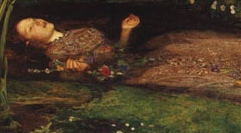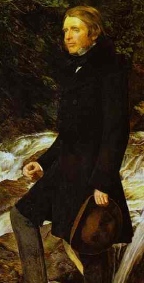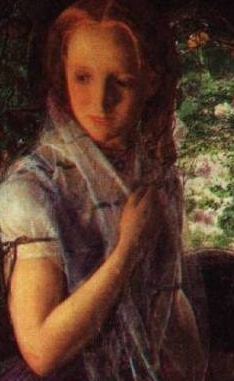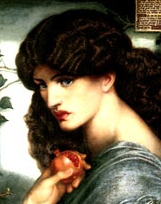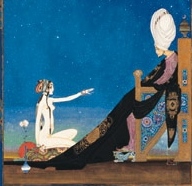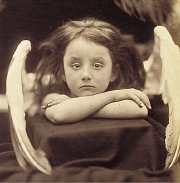Sleep Pale Sister
and Pre-Raphaelite Fiction
The Agony Column for October 15, 2004
Commentary by Serena Trowbridge
Sleep, Pale Sister
Black Swan
and Pre-Raphaelite Fiction
The Agony Column for October 15, 2004
Commentary by Serena Trowbridge
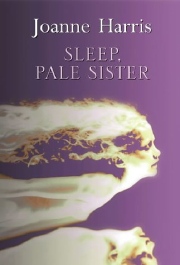 |
| The Black Swan re-print of Joanne Harris's second novel, Sleep Pale Sister. |
Sleep, Pale Sister
Joanne Harris
Black Swan
UK Paperback
ISBN: 0-552-77178-3
Pages: 400; Price: £6.99
Date Reviewed: 15th September 2004
Reviewed by: Serena Trowbridge
So perhaps this is the right time for Black Swan to reprint Sleep, Pale Sister, Joanne Harris’s second novel. (The first being The Evil Seed, which she would rather remained forgotten and out of print!) It is also the right time in Harris’s career, given that she is now enough of a name to sell books easily, and this one is more like her most recent novel, Holy Fools, than the lighter and brighter Chocolat for which she is most famous. She has been told that she is a very visual writer (for which perverse reason she is now making the narrator of her next novel, The Man Who Sold St. Oswald’s, blind) and this is an exceptionally visual book, as befits a novel about artists and artists’ models.
Apparently on his wedding night Ruskin was so shocked to discover that women have pubic hair that he fainted and refused to consummate the marriage. Effie later found happiness with Millais, while Ruskin went on to nurture a hopeless passion for the (even younger) Rose La Touche (who later died insane), and it is apparently this story which inspired Joanne Harris. There is no doubt that this novel, like the stories and myths surrounding the Pre-Raphaelites, contains all the staples of good Victorian Gothic fiction: death, sex, cemeteries, London, ghosts, beautiful women, and of course art, mixed together for an unforgettably chilling tale. Henry Chester, looking for models to paint, finds a young girl (also called Effie), whom he paints constantly and in whom he finds his ideals of purity and chastity. He moulds her into the young woman she becomes and marries her; however, he is reluctant to consummate the marriage as he is afraid of corrupting her. The ethereal and initially innocent nature and appearance of Effie seems to me to be the ideal of Arthur Hughes’ painting, April Love (below), which Ruskin described as “exquisite in every way”, and for which the model was Hughes’ young wife, Tryphena Ford. I am beginning to spot a pattern.
This dual role takes its toll on Effie, her mind clouded and drugged, andthe novel unfolds irresistibly. The respectable face of Victorianism is portrayed delicately and clearly, with the hidden underworld (the side which fascinates the twenty-first century) equally well delineated. The novel, with its recreation of Victorian life and with its subtle and sinister ghost story reminds me a little of Affinity, Sarah Waters’ novel of the Victorian fascination with the occult, and if you liked that you’ll certainly enjoy this.
However, there is another side to this novel; the Pale Sister of the title is drawn from one of Rossetti’s poems, My Sister’s Sleep, which you can read online here. The poem, written in 1847, is the verbal equivalent of Rossetti’s pictures, idealizing a dead, beautiful sister, who lies on her bed in the moonlight on Christmas Eve while around them people are celebrating. This is easily comparable to the listless Effie, lying drugged in her room while a life of which she has no knowledge goes on in the world about her, and has resonance for later events in the novel, which I will let you find out about yourself.
This image is used as a metaphor throughout the novel, both as a depiction of the trickery of women, and the need that Chester feels to destroy any woman he lusts after. The novel also takes the conventional Victorian beliefs about the naturally hysterical and base nature of women pitted against the innate logic and superiority of men, and shows the falsehoods and double standards on which this is founded. While some of the women in the novel are not good per se, the majority of the men are evil, with secrets eating away at them, from debts to death. Joanne herself says, in an interview with Kevin Mahoney: “I did have Ruskin quite strongly in mind when I wrote SPS, as well as a number of other Victorian writers and artists. I'm fascinated by the amazing dual standards of Victorian morality - and endlessly amused when well-meaning politicians talk about "returning to good old Victorian values". Certainly a whole culture of institutionalized pedophilia (disguised as idealism) amongst the Victorians has been modestly glossed over by historians, as has their rather special attitude to sex, reflected now in the enduring passion of the fashion industry for childlike, waif-thin models. I wanted to talk about that to some extent, and to explore what might happen if that ideal were actually to take an identity of its own.” The psychology of the novel is also interesting, with Harris trying (perhaps occasionally just a little too hard – something to which she is not prey these days) to show what in the lives and especially childhoods of her characters caused them to grow up and develop as they did. The seeds of the writer Harris has become are clearly sown in this novel, however. It is perhaps slightly less polished than her later work, but no less confident, and no less enjoyable, either. Another recent novel which is working the Pre-Raphaelite vibe at the moment is Pale as the Dead, by Fiona Mountain (see review). Again this is a novel which concentrates on the seamier side of the Victorians, in this case with a genealogist using clues from the past to untangle the secrets of the present, which is yet another facet of the general public’s love affair with history. Here, the “ancestor detective”, Natasha Blake, traces a family line back to the doctor of Rossetti, and finds herself unraveling secrets that subsequent generations have puzzled over, in this case the mysteries of the life of Elizabeth Siddal. Her exploration of the life and nature of the Pre-Raphaelite Brotherhood is necessarily less explicit than Harris’s, but equally compelling, and the mechanism of the story allows Mountain to dream up answers that fit into the picture of history very conveniently, if in a rather romantic manner (of which the Pre-Raphaelites themselves might well have approved!)
For further information, there are a number of sites (varying
in academic value) on the internet which look at the history of
the Pre-Raphaelites, but I would like to recommend the Pre-Raphaelite
Society, which is based
in the UK but has a US arm and has done a lot of excellent work
in promoting the Pre-Raphaelites. If you have suggestions for other novels which
have Pre-Raph connections, please email
me. Thanks! |
||||||||||||||||||
[1] Although a fantastic book, made into slightly less fantastic film, The French Lieutenant’s Woman by John Fowles has a surprise Pre-Raphaelite twist at the end, but I won’t say anymore to spare those who haven’t read it yet![Return] [2] Possession is one of my favorite books, although I wouldn’t recommend you see the film as a substitute for the book: it misses out a lot of the story, although it is lushly shot with evocative Victorian interiors. It deals with a scholar researching the poems of a mysterious Victorian poet, and has strongly Pre-Raphaelite overtones, both in the vivid pictorial details and in the Gothic and melancholy atmosphere which always pervade such books. No-one is interested in happy and normal Victorians these days; it’s all about those who were mad, bad and dangerous to know! [Return] |
